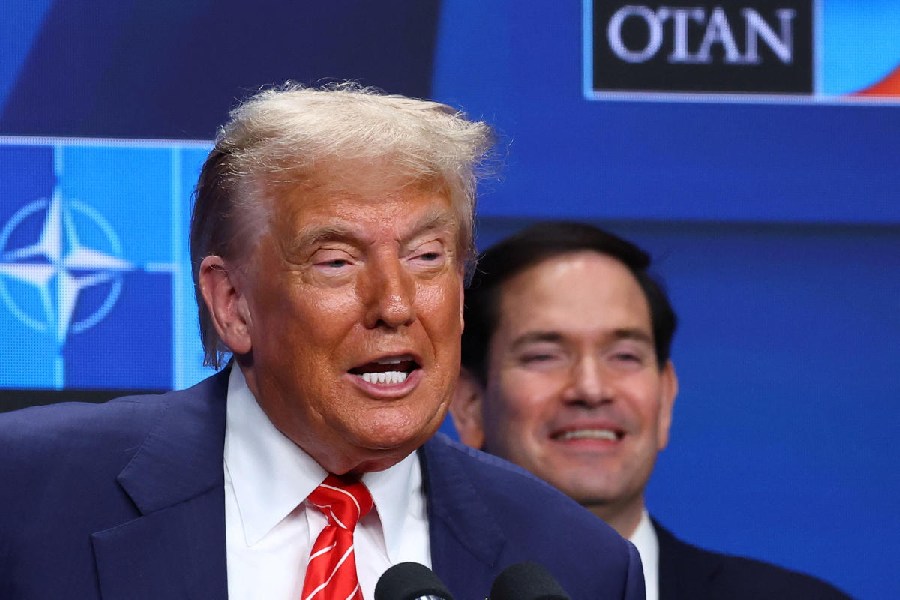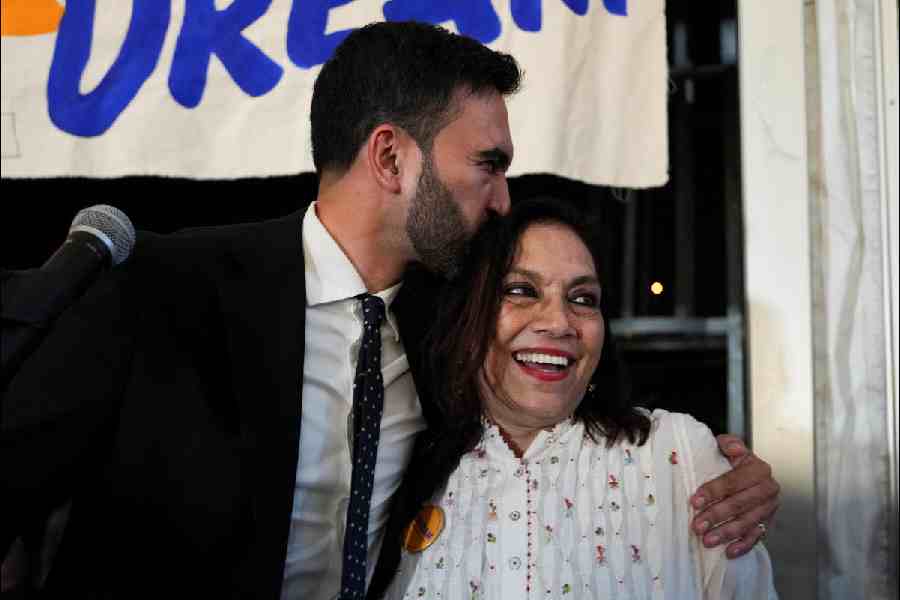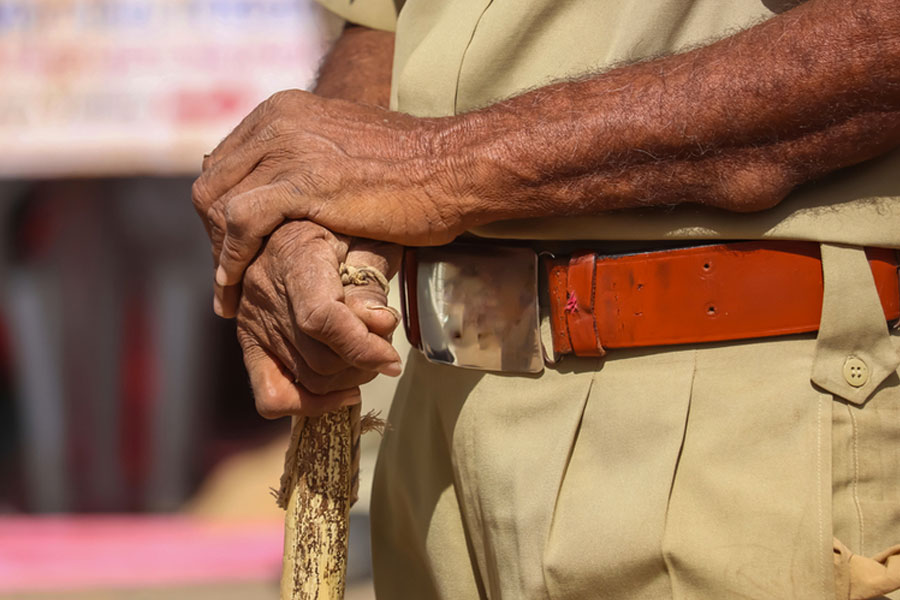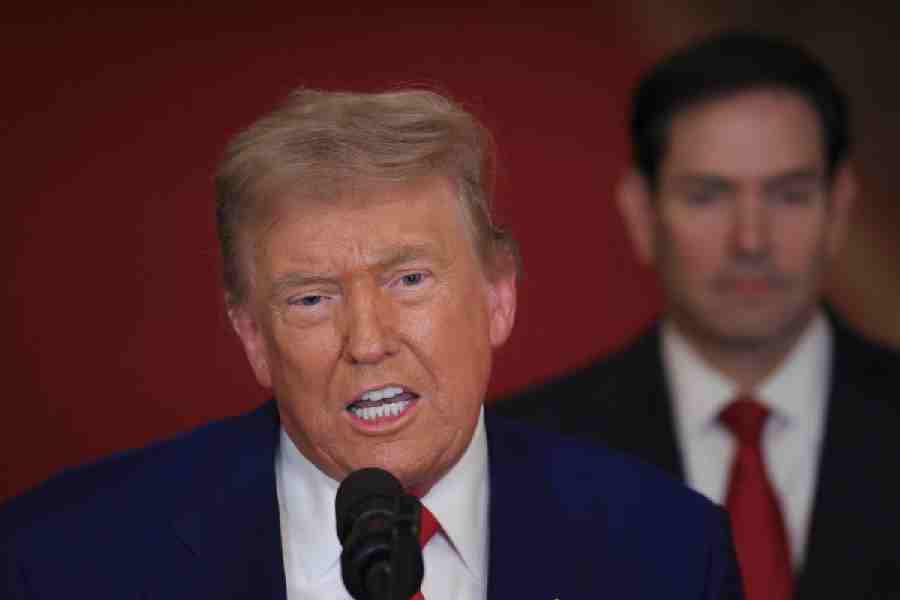 |
| Dibakar Banerjee and Sushant Singh Rajput in conversation with t2 at Aromas, Kenilworth Hotel. Pictures: Anindya Shankar Ray |
For more than half a month now, they have been living and breathing Byomkesh in the lanes and bylanes of Calcutta. On a rainy Sunday evening, t2 caught up with team Detective Byomkesh Bakshi — director Dibakar Banerjee and leading man Sushant Singh Rajput — for a sneak peek into their interpretation of the life and times of one of Bengal’s favourite sleuths.
How much of an experience has your 15-day Calcutta recce been?
Dibakar: This was an orientation into Calcutta. It’s been about relating the current Calcutta to the vintage Calcutta that I want to portray, and also relating Calcutta to the story that I want to tell because every story has a geography. The way Sharadindu (Bandopadhyay) wrote it… he mentioned his hero residing in a particular para, crossing over from this road to that road…. For me, this time, it was a study into these neighbourhoods and how they have changed. It’s been a very intense experience because I have realised how much of a living museum Calcutta is. There’s so much of living history in every corner. I see a lot of it is disappearing so callously and insensitively, but despite this disintegration, there is this huge mass of Calcutta that is waging its own battle to conserve history. Like today, I was in old Chinatown and I met this group of people who had successfully stopped the demolition of one of the most beautiful relics of that area, the Nangking Restaurant that Uttam Kumar used to visit.
That’s a film in itself, isn’t it?
Dibakar: I think so. It definitely is a very contentious documentary film on how Calcutta is a living museum and a graveyard at the same time. I haven’t seen this kind of history and presence of history consciousness in Delhi or Bombay. Being in Calcutta is a sense of being alive. I found it terribly exciting… how at every corner you are dealing with the then and now. He (gestures to Sushant who’s just walked in) is not a Bengali but he’s the one who mentioned this first, how there are so many things about Calcutta that hit you….
Sushant: People that you don’t even know are so willing to help, to share information. That’s so rare elsewhere.
Sushant, what are the Bengali things you have been doing to play Byomkesh?
Sushant: The main thing has been food (laughs). But for everything else, I am not comfortable sharing it right now because I, myself, am not sure what I am doing (smiles). But everything that takes to understand Calcutta and its people better, I am doing that.
Dibakar: One of the games that we have been playing is: ‘How to walk like a Bengali of 1942’! Gyms weren’t there then… body consciousness wasn’t there. The biggest star, probably, had a potbelly. There were very few cars… Byomkesh probably walked a few kilometres a day. How he walked must have been so different from how Sushant walks. Like today, we were coming out of Bengal Club, and I told Sushant: ‘No, not that walk!’ And he was like: ‘I know, but right now please let me walk the way I want to!’ (Laughs)
During your research, where did you see 1942 the most in today’s Calcutta?
Dibakar: Everywhere! You walk down Park Street and take a corner and you find some history there, but at the next moment, you step into something contemporary. You have to find those corners. The yellow-coloured building that I see from my hotel window every day looks like it is at least 110-120 years old.
Sushant, have you been venturing out on your own to get a feel of Calcutta?
Sushant: It’s been a very planned approach. I’ve been meeting a lot of families… people who have been around in 1942. There’s been a lot of discussion, a lot of questions and answers and I may not be able to use all of them in enhancing my portrayal of Byomkesh, but just hearing those anecdotes is so enriching.
Dibakar, was Sushant always your first choice for Byomkesh?
Dibakar: Always. I wanted a 22-23-year-old Byomkesh fresh out of college who wants to become a detective. Frankly, the film has a certain commercial appeal and it needed a star of that stature. Three-four names came up and I knew immediately that Sushant was that guy who fitted the character. He’s an internal actor and is a much more reticent person than many others in the industry. He uses that to his advantage in his performances.
Did the fact that he is just a film old and doesn’t have an image yet contribute to casting him?
Dibakar: It was actually a very, very positive factor because I wanted someone with a huge amount of promise, but with less exposure. Byomkesh is a star by himself and if you have a face that is very well known, the reinterpretation of Byomkesh will be very difficult. I want to start Byomkesh from the beginning and I feel that there can be no better canvas for Byomkesh than Sushant. The biggest excitement for me has been to take someone so contemporary and transport him to a period that he hasn’t been exposed to. It’s Sushant’s complete diametrical opposition to the presumed image of what a detective in 1942 should be is what makes this very attractive for me.
Sushant, you had no exposure to Byomkesh before this...
Sushant: Well, I did have some kind of idea about Byomkesh and I knew that he was India’s most popular detective. He’s been shown again and again in Bengali cinema, interpreted and reinterpreted in different ways. With Dibakar directing, I knew I was in safe hands.
Dibakar, what did you think of Sushant in Kai Po Che!?
Dibakar: I won’t tell you that! That’s because every director has his own ego… if I don’t have an ego, I can’t direct. Every director needs to think that his actor will deliver his best in his film. So, when I look at Sushant, I look at him as ground zero… the beginning. In my film, I feel Sushant will deliver his best-ever performance. It’s my selfish directorial ego… you can’t do anything about it (laughs).
Sushant, when Dibakar says that, does that put pressure on you?
Sushant: No, it excites me! It’s such a high for an actor that his director thinks so highly of him… that he thinks he will realise his full directorial potential with a film that stars you. It’s a huge thing for any actor.
Sushant, which is your favourite Dibakar Banerjee film?
Sushant: His first film, Khosla Ka Ghosla! It had a certain simplicity that still resonates. It was the first of its kind. I also liked his short in Bombay Talkies.
Does the fact that Sushant is so reserved also contribute, in a way, to the prep for the film?
Dibakar: (Laughs) You know, today we were pumping someone for information about Sharadindu Bandopadhyay’s personal behaviour because I feel that in every creation, there is a bit of the creator. He told us that Sharadindu was very quiet and reserved.
Sushant: I’ve just started out and as much as I can speak or want to speak about a lot of things, I find it easier to keep quiet. That’s how I am (smiles).
There’s also a budding director in Sushant. How proactive has he been with his inputs during your stay here?
Dibakar: In Calcutta, we are working as a tag team. He’s gone for location recces himself at the same time as I have been. Sushant has been observing and absorbing a lot and has been meeting people who are fanatically knowledgeable about Byomkesh. His eyes light up every time he finds a Byomkesh fan. He’s using fan perception of Byomkesh to understand how he should portray him better.
Dibakar, was the process of acquiring all the 31 Byomkesh titles initiated by you or Yash Raj Films?
Dibakar: Adi (Aditya Chopra) and I reached this decision jointly. Anjanda (Dutt) is coming up with a third Byomkesh… Rituda’s (Rituparno Ghosh) will also come up shortly. While there’s always the thing about variety, I wanted to ensure that while I am introducing Byomkesh to the pan-Indian audience, no other Byomkesh film should happen to dilute the image of Byomkesh in the audience’s mind.
Why Byomkesh and not Feluda?
Dibakar: Because Feluda is kishor sahitya (children’s literature). And anyway, Feluda will be made by Babuda (Sandip Ray). Feluda, along with Byomkesh, is my favourite detective, but for some reason ever since I was 14, the cinematic images that I had were always connected to Byomkesh and not Feluda.
Which Byomkesh films are your favourite?
Dibakar: I’ve watched all Byomkesh films… I am now looking for Manju Dey’s Byomkesh (Shajarur Kanta, 1974). I am using all the Byomkesh films as my textbooks. I am learning from Chiriyakhana (with Uttam Kumar as Byomkesh)… I am learning from Abir’s (Chatterjee) portrayal of Byomkesh and I am very much looking forward to Sujoy’s (Ghosh) turn as Byomkesh. My Byomkesh will have the collective learning gleaned from all these Byomkeshs. It’s a very unfair advantage that I have (smiles).
What do you think of Sujoy Ghosh’s casting as Byomkesh?
Dibakar: I find it very interesting. That someone who hasn’t ever acted before is coming on screen as Byomkesh gives the film an edge. Like Sushant, Sujoy is someone you will never connect to Byomkesh. And that’s where the attraction lies for the audience.









